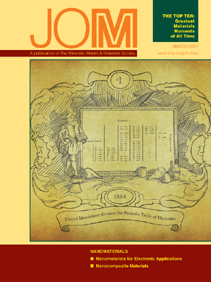|
JOM-e: SPEAKERS’ SLIDES
|
“Materials Informatics: Theory and Application,”
by Krishna Rajan
This presentation provides an overview of the use of informatics in bio-related fields
and comparisons that can be drawn toward the development of materials informatics. The
use of materials informatics as a “tool for materials discovery” is introduced.
“NSDL Materials Digital Library Pathway,”
by Laura Bartolo
The National Science Digital Library (NSDL) Materials Digital Library Cyber infrastructure
was established to facilitate the sharing of data and results between research
groups and across discipline.
“Data Organization and Knowledge Discovery,”
by Paul Mason
The combination of computational thermodynamics and materials informatics goes beyond
simple binary and tertiary phase diagram prediction to filling gaps in experimental
data and prediction of multi-component alloys.
“Data Patterns and Links to Materials Theory: Theoretical Foundations
for Heuristic Pattern Detection,”
by Kim Ferris
This presentation introduces the concept of an information hierarchy where data from
different levels correlate with distinctive physical properties. Structure mappings are developed
from knowledge extraction and provide the common linkage among crystal structures,
thermodynamic data, and phase descriptions, which form the basis of CALPHAD.
A methodology for combining first principles, “knowledge bases,” and materials informatics
is highlighted.
“Data Mining and Materials Informatics: A Primer,”
by Krishna Rajan
These slides offer a primer for sources of data, data mining, and the prediction of
material properties. Central to this effort is the coupling of computational materials science
with materials informatics, building toward an information science based design of
materials.
“Computational Materials Science and Materials Informatics: Glossary,”
by Kim Ferris
A glossary of terms is presented that are pertinent to computational materials science
and materials informatics.
|
Advances in technology are frequently
driven by and even depend upon
advances in materials. Yet the time and
expense required for the development
cycle—the years of formulation, synthesis,
performance testing, characterization,
modeling, reformulation, and
other activities—increasingly handicap
the introduction of new materials to the
marketplace.
Given current pressures on economic and research competitiveness, new R&D
strategies must be found that decrease
product development cycle times and
their associated costs. One of the most
promising is materials informatics.
A workshop titled “Material Informatics:
Theory and Application” was held
at the Materials Science & Technology
2006 conference in Cincinnati, Ohio
on October 15, 2006. The workshop
provided an introduction to materials
informatics with a review of issues and
discussion of applications provided by
panelists who are practitioners in the
field followed by a panel-directed forum.
Panel members included Krishna Rajan
of Iowa State University, Laura Bartolo
of Kent State University, Kim Ferris of
Pacific Northwest National Laboratory,
and Paul Mason of ThermoCalc Software,
Inc.
Materials informatics is an emerging
field that aims to accelerate the development
cycle through high-speed and
robust acquisition, management, analysis,
and dissemination of diverse materials
data. Materials informatics includes
the research, development, and application
of information about materials
properties (including both physical data
and theoretical and empirical models)
and the software tools for querying and
mining those databases.
As described at the workshop, informatics
researchers create frameworks to
acquire and store data, fuse complex and
disparate data, and add theoretical and
computational models. Digital libraries
of materials property information and
existing computational tools for predicting
material properties are important
resources in informatics; their development
has laid much technical groundwork
for informatics approaches.
The structured environment developed
from measurement or computation is no
longer simply a single data point; it is
a step in an information-based learning
process that uses the power of a collective
to achieve greater efficiency in new
materials exploration.
Loni Peurrung is director of the Materials Division
and Kim Ferris is chief scientist, Materials Discovery
at Pacific Northwest National Laboratory in Richland,
Washington. Todd Osman is TMS technical
director. Loni Peurrung can be reached at (509)
375-2878; e-mail loni.peurrung@pnl.gov.
|


